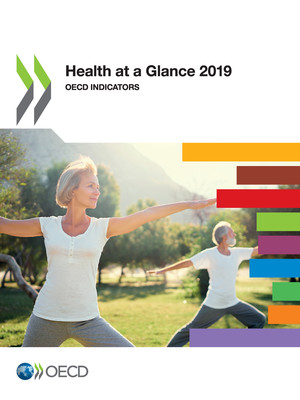copy the linklink copied!Remuneration of nurses
On average across OECD countries, the remuneration of hospital nurses was slightly above the average wage of all workers in 2017. In most countries, their remuneration was in the range of being about 10% lower than the average wage to 20% higher. However, in some countries like Lithuania and Latvia, nurses earn much less than the average wage of all workers, while in other countries like Chile, Mexico, Israel and Luxembourg, they earn much more (Figure 8.12). .
Converting the remuneration of hospital nurses to a common currency (here US dollars) and adjusting for purchasing power parity (PPP) reveals a sizeable variation in the income of hospital nurses across countries. In 2017, nurses in Luxembourg had remuneration levels six times higher than those working in Latvia and Lithuania (Figure 8.13). In general, nurses working in Central and Eastern European countries have the lowest levels of remuneration, explaining at least partly that many of them migrate to other EU countries (OECD, 2019[1]).
The remuneration of nurses in the United States is higher than in most other OECD countries, explaining why the United States is able to attract several thousands of nurses from other countries every year.
In most countries, the remuneration of nurses has increased since 2010, albeit at different rates (Figure 8.14). In some countries, like the Czech Republic and the Slovak Republic, nurses have obtained substantial pay raises in recent years. In the Czech Republic, nurses benefitted from a pay increase following protests of hospital workers in 2011 (although their pay rise was lower than that given to doctors), accompanied by improvements in other areas of their working conditions (OECD, 2016[2]). The remuneration of nurses in the Slovak Republic increased by about 40% between 2010 and 2017, and in 2018 the Slovak government also announced a further increase of at least 10% in the salaries of nurses and other non-medical health professionals.
In other countries, like Portugal and Spain, the remuneration of nurses fell after the 2008-09 economic crisis due to remuneration cuts in the public sector and have only recovered slowly in recent years. . This was also the case in Greece where the salaries of nurses decreased by about 25% between 2009 and 2015.
The remuneration of nurses refers to average gross annual income, including social security contributions and income taxes payable by the employee. It should normally include all extra formal payments, such as bonuses and payments for night shifts and overtime. In most countries, the data relate specifically to nurses working in hospitals, although in Canada the data also cover nurses working in other settings. In some federal states, such as Australia, Canada and the United States, the level and structure of nurse remuneration is determined at the sub-national level, which may contribute to variations across jurisdictions.
Data refer only to registered (“professional”) nurses in Canada, Chile, Ireland and the United States, resulting in an over-estimation compared to other countries where lower-level (“associate professional”) nurses are also included. Data for New Zealand include all nurses employed by publicly funded district health boards, registered and otherwise, and includes health assistants who have a different and significantly lower salary structure than registered nurses.
The data relate to nurses working full time, with the exception of Belgium, where the data provided also include part-time nurses (resulting in an under-estimation). The data for some countries do not include additional income such as overtime payments and bonuses (e.g. Italy and Slovenia). Informal payments, which in some countries represent a significant part of total income, are not reported.
The income of nurses is compared to the average wage of full-time employees in all sectors in the country. The source for the average wage of workers in the economy is the OECD Employment Database.
References
[1] OECD (2019), Recent Trends in International Migration of Doctors, Nurses and Medical Students, OECD Publishing, Paris, https://dx.doi.org/10.1787/5571ef48-en.
[2] OECD (2016), Health Workforce Policies in OECD Countries: Right Jobs, Right Skills, Right Places, OECD Health Policy Studies, OECD Publishing, Paris, https://dx.doi.org/10.1787/9789264239517-en.





